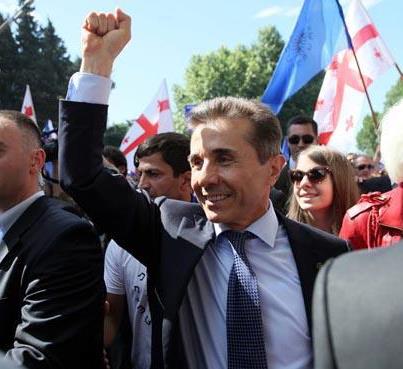
Ivanishvili’s Georgian Dream: Proprietary Electoral Coalition Takes Shape
Publication: Eurasia Daily Monitor Volume: 9 Issue: 140
By:

Bidzina Ivanishvili, multi-billionaire leader of the Georgian Dream opposition party and coalition, has almost completed the nomination of candidates for the upcoming parliamentary elections in single-mandate electoral districts. Most of these candidates are non-political individuals (veteran cultural figures and sportsmen, some employees of Ivanishvili’s organizations) who have benefited from Ivanishvili’s generous donations for years. Some small-party politicians shared in that munificence since Ivanishvili launched his power bid in October 2011.
In a series of campaign rallies throughout Georgia between June 10 and July 19, Ivanishvili has personally anointed 68 of the coalition’s 73 candidates for the single-mandate districts. Each of these districts elects one deputy to parliament on the winner-take-all rule: the first-placed candidate wins the election on the first round (a second round is held if the frontrunner candidate garnered less than 30 percent of the votes in the first round). As a rule, political parties try to assign their most respectable candidates, with highest name-recognition locally, to run in single-mandate electoral districts (see accompanying article).
Georgian Dream is nominally a coalition, dominated by Ivanishvili’s eponymous party, with several small groups in its tow. The title Georgian Dream applies both to Ivanishvili’s party and to the coalition he has built around it. Reflecting his control, based on financial power, over the entire coalition, Ivanishvili himself announced all the nominations, including those on behalf of the dependent parties, at the recent rallies. Leaders of satellite parties did not make appearances to announce their candidates; Ivanishvili did this for them (Civil Georgia, June 10 and 17, July 1, 9, 15, 17, 19).
Three common features define almost all of these candidates’ political profiles. First, they hark back for the most part to the 1990s in terms of social status acquisition, mentalities and interests. Second, most of them lack exposure to the West or fluency in English. And third (related to the former), their track records show no contribution to, interest in, or comprehension of Georgia’s post-2003 reform policies and Euro-Atlantic integration efforts thus far. They were simply not involved in that debate and that action over the last decade. These characteristics are common to all Georgian Dream party candidates in this cohort, without any noticeable exception. Only a few candidates from smaller parties in the Georgian Dream coalition differ from that general profile.
On a personal basis, most of these candidates are beholden to Ivanishvili in one way or another. He subsidizes cultural figures and former star sportsmen who lost their state salaries in the post-Soviet era (Ivanishvili “pays their salaries,” in a phrase reminiscent of former state entitlements). Many of these beneficiaries are now his candidates for parliament. A lavish and discrete donor, supporting cultural pursuits that may otherwise have been impossible during these years, Ivanishvili is now cashing in on his long-term investment in personal loyalties. He has also made a short-term investment since October 2011, co-opting small political groups with no campaign resources of their own, other than Ivanishvili’s fresh infusions. These groups are the newcomer Free Democrats (led by Irakli Alasania), the veteran Republicans (permanently led by the Usupashvili-Khidasheli husband-and-wife team and the Berdzenishvili brothers) (www.georgiandream.ge, accessed July 23), and three still smaller factions.
In some ways, the Georgian Dream coalition resembles the communist-orchestrated coalitions (known as “bogus coalitions”) in East-Central Europe after the Second World War. The resemblance is not ideological, as the dominant party Georgian Dream is an eclectic one. The resemblance can be seen in the coalition’s structure and operation. The main elements include: a hegemonic party; a cluster of satellite parties dependent on the hegemonic party’s resources; the leading party influencing the small parties’ internal decisions; active recruitment of fellow-travelers from among cultural figures (now updated with sporting figures); and marginalization of Western-oriented elements in favor of parochial, provincially inward-looking ones.
Within the coalition, the Georgian Dream party is top-heavy with cultural and symbolic figures. In this sense it continues a tradition of Soviet-era “front organizations,” canvassing public support for handed-down decisions.
Ivanishvili operates, in effect, as proprietary leader of the Georgian Dream party and coalition. This coalition is bound together by Ivanishvili’s patronage, presumably ensuring support for their benefactor’s decisions. Given the volatility of Georgia’s opposition in past elections, no guarantees could be expected to hold at that time. These elections will be different, however. Ivanishvili’s funding can potentially hold the coalition together, far more effectively than was the case with earlier electoral coalitions. By nominating Georgian Dream’s candidacies in single-mandate districts, Ivanishvili has taken a first major step toward purchasing a share of parliamentary seats in his state-capture attempt.




